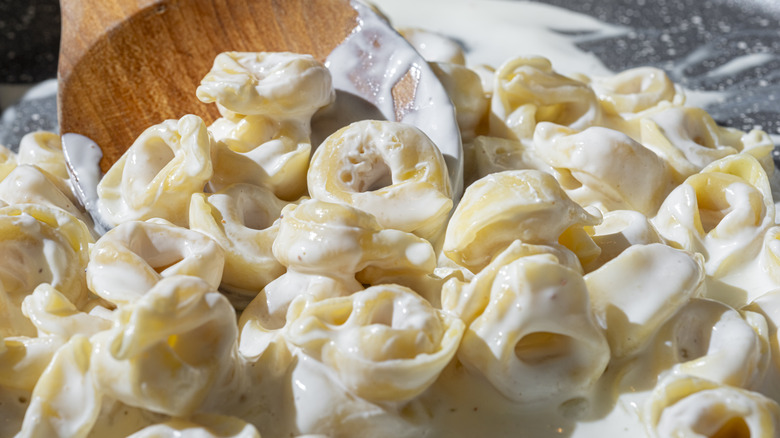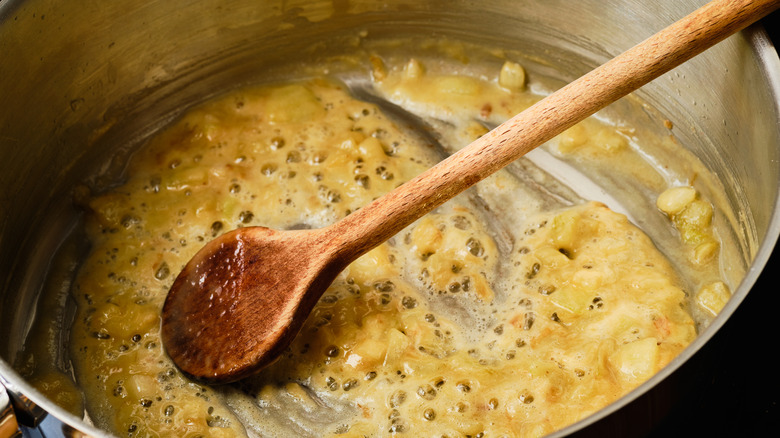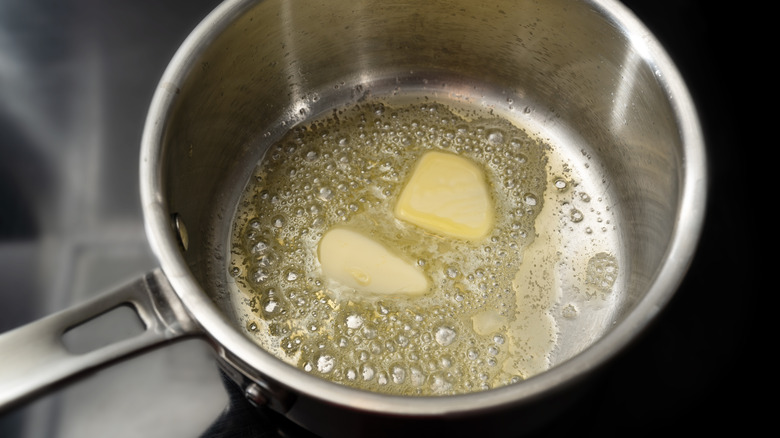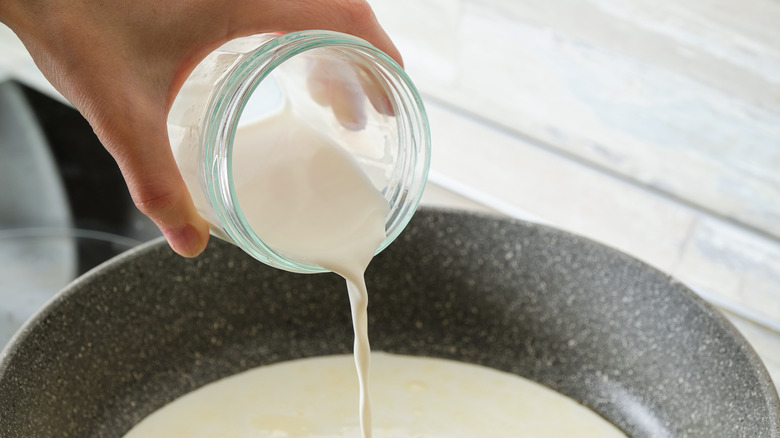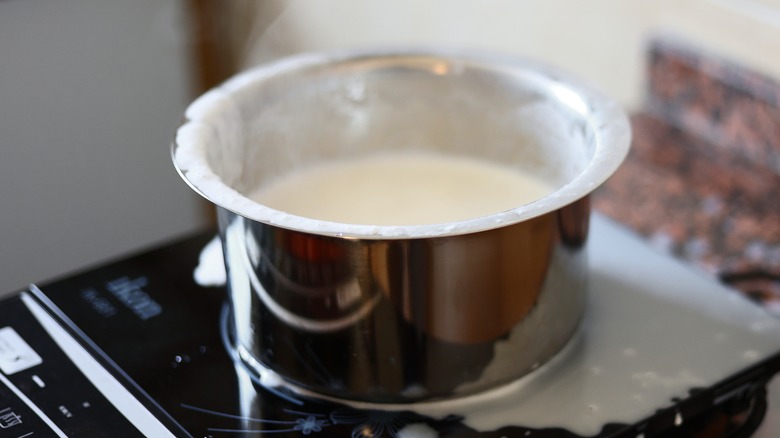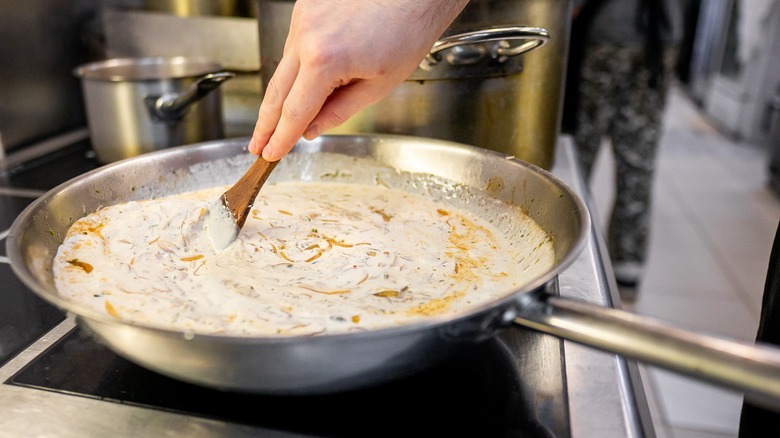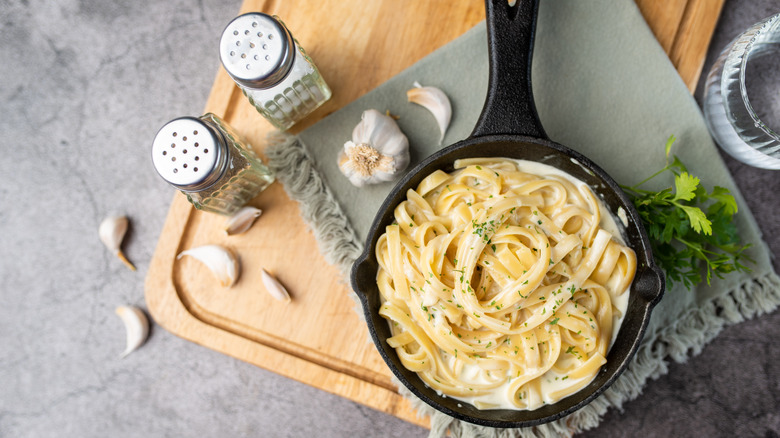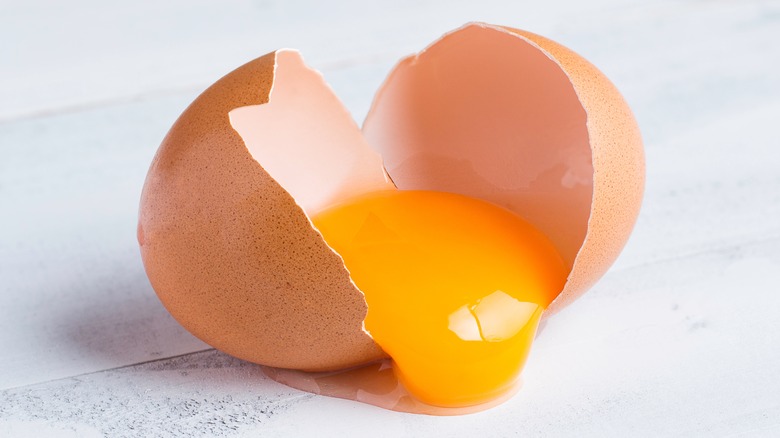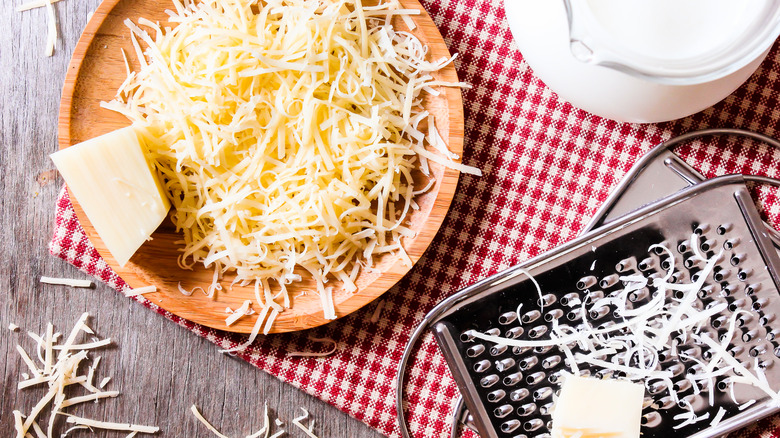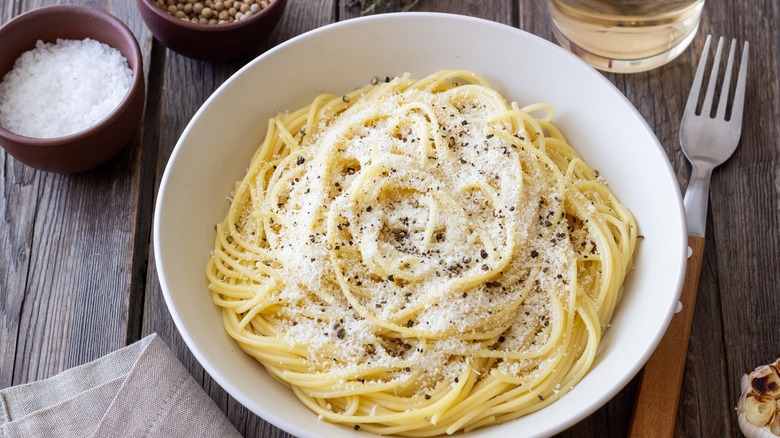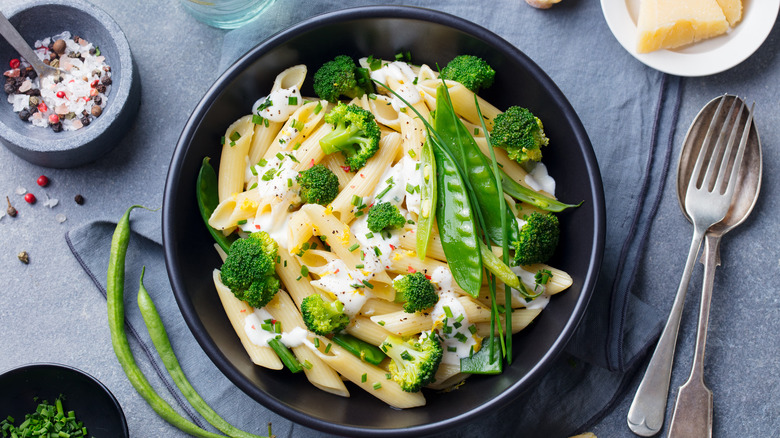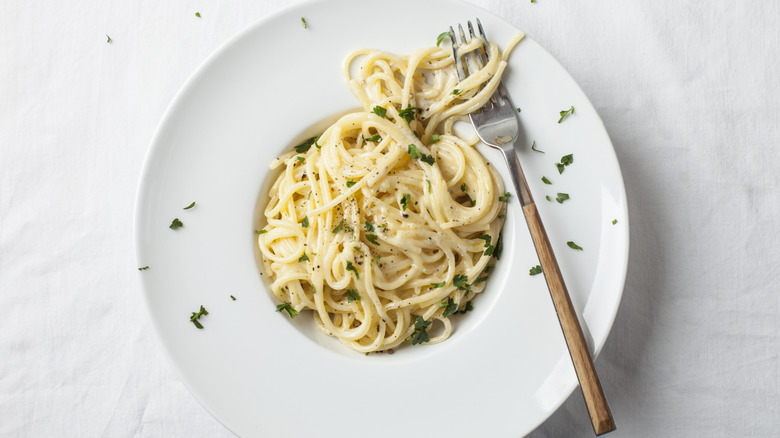13 Mistakes To Avoid When Making A Creamy Pasta Sauce
Creamy pasta sauces may seem a bit intimidating at first, but they are actually quite simple to make. Homemade sauces also taste a whole lot better than the stuff you buy in a jar. Plus, it's pretty uncommon to find anything other than Alfredo when using store-bought cream sauce. You can forget about gorgonzola, mornay, cacio e pepe, and all the other kinds of mouth-wateringly delicious creamy pasta sauce. As a result, learning to make creamy pasta sauce from scratch is well worth the effort. Of course, you'll want to steer clear of a few common mistakes, but again, it's not rocket science.
Once you know what blunders to avoid, whipping up a fresh creamy pasta sauce is actually pretty straightforward. I should know. Pasta sauces are one of our specialties and we particularly love the creamy cheesy ones. With this in mind, many of the upcoming mistakes to avoid with creamy pasta sauce are ones we've made (some more than once). Keep reading to find out what they are so with any luck, you never fall prey to one again.
Insisting on starting with a roux
A well formed roux (mixture of butter and flour) will take you a long way with creamy, cheesy sauces when it comes to achieving a super thick texture. While some people will tell you they are an essential first step in making a proper creamy pasta sauce, we found this simply isn't true. In fact, many recipes for fettuccine Alfredo, gorgonzola cream sauce, or cacio e pepe don't use roux and you certainly won't find it in carbonara. Any béchamel worth enjoying starts with a roux, but every other kind of creamy pasta sauce doesn't need it. Will a roux hurt these other sauces? No, but why bother with the extra step and ingredient when it absolutely isn't necessary?
Instead of using a roux to make your creamy pasta sauces, just let them simmer and reduce until they achieves the desired texture. There are also lots of ingredients you can add to make your pasta sauce creamy and thick, and none of them are roux. For starters, cheese is always welcome (would it even be a creamy sauce without it?). Greek yogurt, ricotta or mascarpone cheese, and even avocado and tofu can also help. They are all so much easier to add than making a roux and they have a ton more flavor, too.
Using cold cream instead of room temperature
It may seem like it is no big deal, but using cold heavy cream, milk, or half and half to make creamy pasta sauces is a big mistake. Instead, your cream of choice should be at room temperature. If you add cold cream to other hot ingredients, it won't mix in as smoothly. It may even split your sauce. If you are making béchamel or another sauce that starts with roux, cold cream could make it lumpy, and no one wants that.
The easiest way to avoid the common mistake is to take your cream, milk, or half and half out of the fridge about an hour before you start cooking. This gives it plenty of time to reach room temperature. If you forget, taking it out of the fridge while you prepare all the other ingredients is still a big help. Or, if you don't remember until it's time to pour it into the pan, you can also warm it up in the microwave or a separate pan (without the butter, roux, or any other ingredients) for a short while. It doesn't need to be hot, but it certainly shouldn't be cold, either.
Holding back on the butter
You may be thinking creamy pasta sauce is already quite heavy and holding back on the butter could be a good way to reduce richness. However, we definitely don't recommend this. The ample amounts of butter in alfredo, cacio e pepe, and other cream sauces are often what gives it such a delicious flavor. You've probably heard someone say butter makes everything better, and we couldn't agree more, especially concerning creamy pasta sauces.
Butter has a fatty, rich taste and cream sauce simply isn't the same without it. In fact, we'd say it's significantly worse. After all, cream doesn't have much of a flavor all by itself. The cheese that goes in most cream sauces certainly helps, but butter makes all the difference. You can always add flavor with other ingredients like herbs, spices, meat, or veggies, but nothing compares to the taste butter imparts. So, just give in and go bonkers with the butter. You can even use more than your recipe calls for — you won't regret it.
Adding all of your cream at one time
Another seemingly innocent mistake to avoid is adding all of your cream to the pan at one time. Instead, you should only add a third or half to start. Then, stir and give it some time to heat up before adding another third or the final half. This method of gradually integrating the cream into the hot butter or roux allows for the ultra smooth texture we all strive to attain.
If you forgo this warning or simply forget in the moment and dump all of your cream in at once, the chances for your sauce becoming lumpy or at the very least uneven go through the roof, especially if it contains roux. In addition, you might think you know how much cream you want to use in your sauce but having the ability to dial it back in the moment gives you more control over the final texture. You may find that you don't need quite as much as you first thought. Stranger things have happened. On the other hand, this gradual addition of cream also means you don't have to worry if you find you actually need more than anticipated. Just keep adding slowly until you get it right.
Scalding the cream or milk
One of the most detrimental mishaps people experience when making creamy pasta sauce is allowing the milk or cream to scald while cooking. Scalded milk not only tastes horrible, but it most certainly won't help in the texture department either. Of course, it is also likely to boil over your pan in the process and leave behind a sticky, hard to clean up mess. Lastly, scalding the cream or milk in any kind of sauce is a mistake you can't bounce back from. In most cases, it means you have to throw it away and start all over again.
To prevent this unfortunate blunder, there are two things you can do: Always cook your creamy sauces on a super low temperature and stir them constantly. Seriously, you should be stirring almost constantly to prevent it from burning and sticking to the bottom of the pan. Continuous mixing is also the best way to get a consistently creamy texture. So, it may seem tedious to keep your sauce on a super low temperature or to stir it so much that your arm gets tired, but the alternative is much worse. Stay on top of your sauce and stir, stir, and keep stirring.
Not facilitating the ideal thickened texture
Once you get all your cream, butter, seasonings, and more into your pan it may be tempting to only leave it cooking for a few minutes. However, you need to make sure it thickens properly before tossing the noodles in the pan as well. When you first add all of your cream or milk it may seem like it will never reach the ideal thick and creamy texture, but as long as you are patient it shouldn't be an issue.
Thickening your basic butter and cream sauce is easily done with some extra time on the stove. The longer it cooks, the more the cream reduces, leaving you with a deliciously thick and tasty sauce. Plus, when you add pasta, it soaks up a considerable amount of sauce, so don't be overly concerned if your sauce is still a bit runny.
Another way to speed up the process and give your cream a nudge in the right direction is to add other thickening ingredients, and I'm not just talking about roux. As it turns out, there are lots of ways to easily thicken creamy sauces. My favorite way is to simply add more cheese, whether it is Parmesan, Pecorino Romano, mascarpone, or some other kind. You can even add the leftover rind from a block of Parmesan to improve texture. Things like cottage cheese, ricotta, sour cream, mayo, and cornstarch also work wonders in the thickening department.
Under seasoning your sauce
Under-seasoning your sauce is one of the worst mistakes you can possibly make. After all, who wants to spend all the time and effort making a sauce from scratch just for it to turn out bland and boring? No one, that's who. So it probably goes without saying, but salt is going to be your friend here, pepper, too. Fortunately, the cheese you use in your sauce should give it a subtle salty taste. Some cheese even packs quite a punch in the flavor department. If your sauce calls for an egg, it'll add more flavor. Basically, even without an abundance of seasonings, your creamy pasta sauce shouldn't be so bland that all you taste is cream, but you can make it much better with some herbs and spices.
White pepper is a great choice if you want to maintain a creamy color. A touch of lemon juice or zest, red pepper flakes, Italian herbs and spices, and nutmeg are other favorites, but thanks to the versatile nature of cheese and cream you can play around with seasonings quite a bit. Whatever you choose, taste as you go, and keep adding until your creamy sauce is brimming with deliciously rich flavor.
Not expanding your cheese options
With classic Alfredo sauce, Parmesan is the tried and true standard. Many people would go so far as to say it isn't even Alfredo if you use a different kind of cheese. However, we say forget the norm, be adventurous, and stray from the pack. What is the worst that can happen? You get a tasty, creamy, cheesy sauce that some haters refuse to call Alfredo? Oh well. That's no sweat off your back. You can mix in Pecorino Romano and Gruyère cheese along with Parmesan in my Alfredo; dare anyone to tell you it isn't delicious, regardless of what you call it.
A world of cheeses can also be used to make other kinds of creamy pasta sauce. There's the obvious gorgonzola for a gorgonzola cream sauce but goat and blue cheese also make yummy renditions. Cream cheese works in surprising ways too when paired with other cheeses. Not only does it add a tangy taste, but it helps thicken your sauce with minimal effort and cooking time. Of course, any number of cheeses like cheddar, Swiss, brie, camembert, Havarti, and muenster can be used to make a yummy béchamel sauce, as well. Or, one of our favorites is Manchego. It has a nice salty taste and smooths out to perfection when mixed with heavy cream.
Avoiding eggs
Eggs aren't always at the top of people's list when it comes to making creamy pasta sauce, unless of course, it's spaghetti carbonara. Even so, eggs shouldn't be completely counted out of the equation for other types of creamy sauce, at least not all of the time. We wouldn't necessarily put an egg in my gorgonzola cream sauce, but we have experimented with putting an egg in a "béchamel" for baked macaroni and cheese and it was very tasty. We got the idea from a cook we know, so we're not the only one who likes it this way, either.
Egg also has the potential to add a rich, fatty taste to Alfredo sauce. It can be mixed in with the roux at the very beginning or added later on. If your Alfredo sauce is too thin, an egg can help with that too. The same goes for a classic béchamel. In both types of sauce, egg can work as a thickening agent.
Using pre-grated cheese
Pre-grated cheese is incredibly convenient. There's no denying it. However, when it comes to making a creamy pasta sauce, opting for pre-grated cheese is a mistake. Aside from the addition of unnecessary additives being somewhat yucky to think about, cheese that actively prevents clumping is not what you want when trying to make a creamy pasta sauce. Ideally, you want the complete opposite: A cheese that smooths out beautifully and doesn't resist forming a creamy texture — duh.
Grating your own cheese is an extra step many try to avoid. Still, even if you resist it for all other cooking applications, do yourself a favor and put in the grunt work when concocting a creamy pasta sauce. Your sauce will turn out much better in the long run and it won't take as much effort to create the right texture in the pan. If cleaning your cheese grater is one of the reasons you typically shy away from using it (coughs, raises hand). Spray it with a light coating of oil first. It works like magic when it comes to wiping away all the leftover cheese residue.
Sticking to Alfredo and nothing else
When you mention creamy pasta sauce, the first thing that comes to mind for many people is Alfredo. However, creamy pasta sauce has a lot more to offer than just that one single variation. It may be a classic, and a tasty one at that, but sticking to Alfredo and nothing else is doing yourself a major disservice. What about the creamy sauce that accompanies mac and cheese? We can't forget that, like, ever. While many people simply refer to it as béchamel, technically it is a Mornay sauce (because it contains cheese). The difference between Mornay and béchamel may be slight, but it exists all the same, so that's two additional creamy pasta sauces you should add to your arsenal.
Gorgonzola cream sauce is another one of my favorites to make. It has a distinct taste that is reminiscent of blue cheese, but it is much more subtle. Then there's cacio e pepe, a simple yet decadent creamy pasta sauce loaded with an abundance of freshly grated black pepper, cheese, and olive oil. It is a bit lighter than a sauce made with cream, but it's just as tasty — promise. Carbonara is another classic fave made with egg and these sauces just scratch the surface of what you can make. Don't be afraid to branch out.
Keeping meat or veggies out of the mix
In addition to all of the helpful tricks and tips discussed so far regarding how to improve flavor and texture in a creamy pasta sauce, there's an obvious way to amp up both: Add veggies and or meat to the mix. Thanks to most creamy pasta sauce's versatility, they also taste phenomenal smothering a myriad of meats and veggies. Actually, most creamy pasta dishes feature at least one vegetable or type of meat already.
Again, feel free to experiment when pairing creamy pasta sauce with other ingredients, meat and veggies included. Anything for farfalle with gorgonzola, ham, and peas to macaroni and cheese with crispy onions, broccoli, and avocado makes an outstanding choice. Spinach, caramelized onions, peas, and artichokes are some of my top vegetable additions. Mushrooms, tomatoes, and spicy peppers are also excellent options. For meat, chicken, steak, ham, prosciutto, shrimp, and more are fantastic options.
Reheating cream sauce too quickly
Reheating any kind of cream sauce quickly is a big no-no. Heating up leftover creamy pasta like you would other foods in the microwave or on a medium to high setting on the stove is guaranteed to break your sauce. In fact, this mistake is so common that we'd be surprised to learn if anyone reading this hasn't done this before. You know the signs, your food still looks slightly creamy, but there is a large amount of oil in the bottom of the bowl or pan. Essentially, the cream and oil have separated, leaving you with a dish that is still tasty, but nowhere near as good as it was or should still be. We're not saying you need to throw a separated cream sauce away, but it's a bummer when it happens.
The key to keeping your creamy pasta sauce intact is reheating it slowly. The best way to do this is on the stove on a low heat setting with a bit of extra cream. We like to warm up a small amount of cream in a pan and then add the leftovers. Keeping it on low typically retains its structure. The microwave is also a viable option, but it's best to only cook your leftover creamy pasta in 20-second intervals with a short rest between. Otherwise, your sauce is sure to split.

